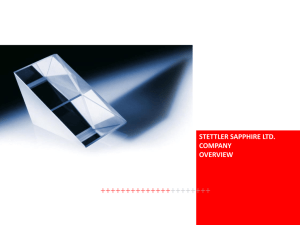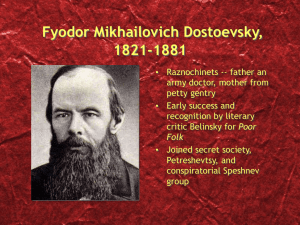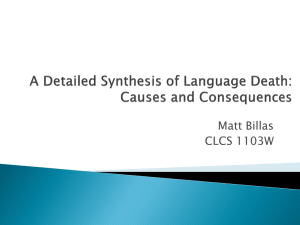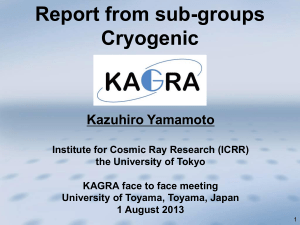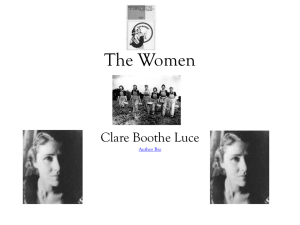f2f 20120204
advertisement
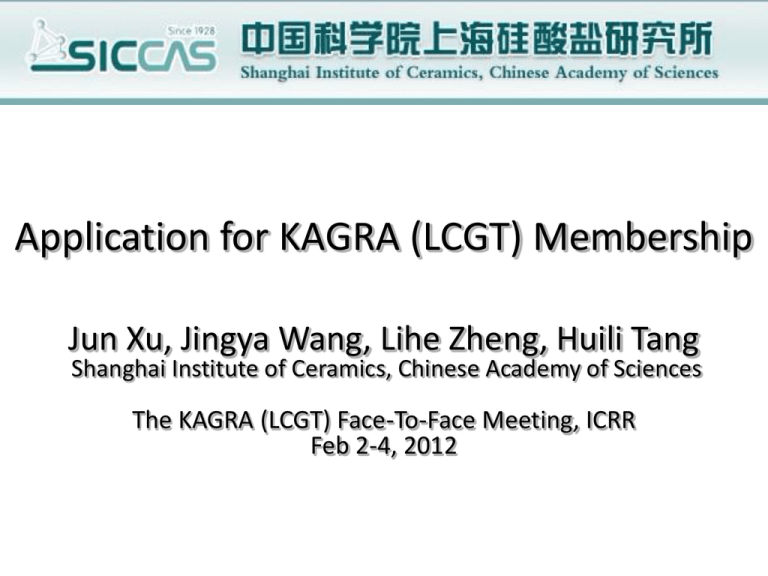
Application for KAGRA (LCGT) Membership Jun Xu, Jingya Wang, Lihe Zheng, Huili Tang Shanghai Institute of Ceramics, Chinese Academy of Sciences The KAGRA (LCGT) Face-To-Face Meeting, ICRR Feb 2-4, 2012 Applicants • • • • Jun Xu: Group Leader Jingya Wang: Machining Research Lihe Zheng: Measurement Research Huili Tang: Crystal Growth Research Outline I. Background II. Motivation III. Proposed Works 1. 2. Large-Size Sapphire Crystal Growth Detection & Machining of Large-Size Sapphire Crystal IV. Facility V. Human Resources VI. Summary I. Background: Core optics of KAGRA f2f meeting, 3 Feb. 2012, Norikatsu Mio, University of Tokyo ETMY Mirrors for Main cavities Initial: Silica Final: Sapphire f10cm Laser MC1 MC3 MT1 PRM PR2 ITMY ITMX MT2 BS PR3 SR2 MC2 f38cm Large-diameter mirrors SR3 SRM ETMX I. Background: Requirements for Sapphire Crystal SHNU-LCGT Round Table Meeting, 19 Aug. 2011, Takaaki Kajita II. Center Activities and Motivation 1. Sapphire crystal research center located in SIC, CAS was founded in July, 2010, aiming at large-size sapphire crystal growth by different crystal growth methods such as KY, EFG, HEM, Cz and TGT. 2. Sapphire crystal research center has strong interests on the experimental challenges of largesize sapphire crystal, led by Prof. Jun Xu from Shanghai Institute of Ceramics, CAS. 3. Experiences in large-size sapphire crystal growth, annealing, detection, cutting and grounding, as well as the home made facilities. To provide manpower for crystal growth experiments and management to meet the optics requirements of KAGRA (LCGT) . II. Center Activities Permanent members (16 now) • Jun Xu (Shanghai Institute of Ceramics, CAS) Leader of SIC-KAGRA (LCGT) Collaboration Experimental: • Growth Parameters (6) ----To optimize the growth parameters and verify the lab designed facility and thermal simulation. • Cutting & Grounding (3) II. Center Activities Permanent members (16 now) Thermal Heater Design (2): ----crucial for obtaining high quality crystal. To obtain homogeneous temperature gradient with improved heater and rectangular shielding set-up. Furnace components, Mechanics, Vacuum and system heater (2): ----Furnace components: attain high temperature and high vacuum. II. Center Activities Thermal Simulation (2): Thermal Simulation: Temperature distribution mode (WT50) WT50 limited gridding WT50 model WT50 simulation results (2810 units, 1467modes) for thermal field IIA. Memorandum – Memorandum on Academic Exchange between the Institute for Cosmic Ray Research, the University of Tokyo & the Sapphire R&D Center, the Shanghai Institute of Ceramics, CAS has been signed up by Jun Xu & Takaaki Kajita on January 8th , 2012. IIB. First Samples sent for Absorption Measurement in KAGRA III Proposed Works: Progress of Sapphire Crystal Growth Verneuil 10-20mmt Abrd China HEM 125mmt CZ 100mmt 1890 HEM 340mmt 65KG 1970 VGF 80mmt TGT 120mmt 8KG KY 300mmt 65KG KY 220mm 1980 1990 CZ 200mmt 2006KY 260mmt30KG 2000 2011 2011KY 400mmt 85KG 2008KY 350mmt 65KG Sapphire crystal grown by VGF TGT: self-possessed initial technology 1. 2. 3. 4. 5. molybdenum crucible seed crystal groove is set at the bottom of the crucible to prevent the seed crystal from melting temperature field was supplied by the graphite heater and the cooling apparatus. Heater cylinder is cut into the shape of rectangular crate and fastened on the graphite electrode plate connecting to the water cooled electrode bar. TGT with Graphite Heater produced crystals with rose pink and annealing was required. TGT: self-possessed initial technology 149mm 118mm 97mm 89mm 69mm Dia.114mm Sapphire grown by HEM By adjusting the Helium gas flow rate and heater power to control the temperature gradient, the crystal is formed slowly from bottom to top by exploiting the heat exchanger Helium to bring away the heat and forming the vertical temperature gradient in the crystal growth zone. Sapphire grown by HEM: XRC & dislocation density y=y0 + (A/(w*sqrt(PI/2)))*exp(-2*((x-xc)/w)^2) Sapphire crystal grown by CZ method 1. Easy to view the crystal growth process. 2. Exploit the seed crystal with specific orientation and apply the neck shrunken techniques to obtain high optical quality crystal with faster growth rate and higher integrity. 3. Defect caused by the uncontrolled complex liquid activity produced by the combined actions of forced convection induced by the rotation of crystal and crucible, together with the free convection arisen by the gravitation. 4. During large crystal growth process, defects are caused by mechanical perturbation Sapphire grown by CZ method: dislocation density & XRC Sapphire grown by CZ method under polarized light: mosaic structure & large boundary Crystal defects such as mosaic structure and lowangle boundary under stress gauge. Principle of KY method 1. a cold seed crystal is lowered to touch the melted raw material 2. crystal is started to grow when the interface temperature is lower than the melting point 3. lift the crystal stage by stage slowly to enlarge the exposed surface. 4. crystal was kept clear of the crucible wall during the growth process and at the end of growth the inside stress would be greatly reduced. 5. However, comparatively large heat thermal shock was produced when crystal departing from the remaining fused mass. Sapphire crystal grown by KY method Sapphire obtained by KY: dislocation density & XRC FWHM (Full Wave at Half Maximum) for the samples at the center with 11.484’’, edge site 1 with 12.276’’ and edge site 2 with 16.992’’ show that the sample with higher crystal quality possessing lower dislocation density. Comparison of different crystal growth method • Venuil, Cz, Float Zone method: Crystal quality and size are both limited which can hardly meet the high requirements of optical application. • HEM, TGT: Large sized sapphire crystal with good quality can be obtained where HEM requiring plenty of Helium as cooling carrier and TGT with Graphite Heater producing crystal with rose pink. • TGT, KY: Post Treatment such as high temperature annealing is required although it’s complex and with high cost. The optical quality of KY crystals are improved after in-site annealing. Comparison of sapphire crystal Technology Dislocation Density (Pits/cm2) FWHM (″) Purity (%) Impurity Content (ppm) KY (Kyropoulos) 102-103 <20 99.996 ﹤1 HEM (Heat Exchange Method) 103-104 CZ (Czochralski ) ﹥103 >20 TGT ﹥103 >15 >15 99.997 99.990 ﹤4 IV. Facilities IV. Facilities IV. Facilities IV. Facilities --Cutting and Grounding for Large Sized Sapphire Crystal single side grounding surface finish testing instrument chamfering machine Automatic chip mounter annealing furnace Spheronizator roughness measuring apparatus optical microscope atomic microscope flatness inspective meter V Human Resources Summary • We will provide significant manpower and sapphire crystal resources for KAGRA (LCGT) experiments. • Permanent Members = 16 • We are willing to expand our participation to wider area. Any suggestions are welcome. Thank you for your attention! xujun@mail.shcnc.ac.cn; 13501650580 Factors that may affect Absorption Parameters 1. 2. 3. 4. Impurity Dislocation Density Micro-defects: Large boundary Micro-defects: Low angle boundary Adjusted by growth parameters and growth method; Defects in the crystals obtained by different growth method results in different emphasizes. • 60kg: dia240-260 mm: 350 mm thickness • 80kg: dia260-280 mm: 400 mm thickness
